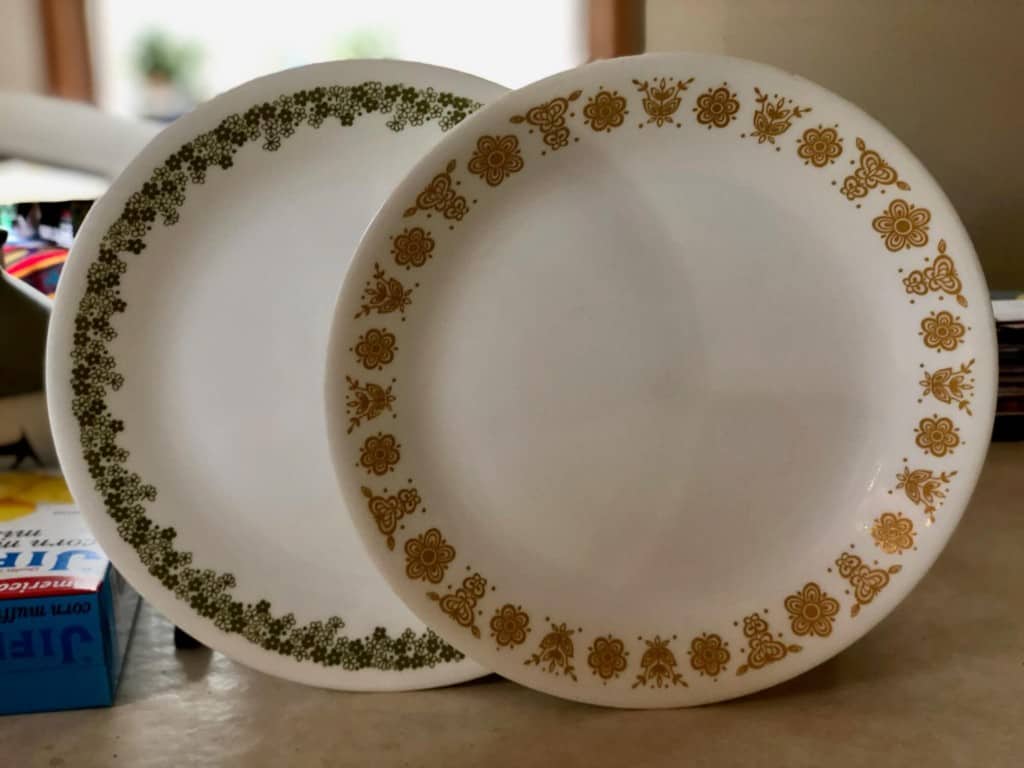
If someone is running late for dinner and you want to keep their food warm, you’ve probably wondered “can I just put the plate in the oven?”
Plates can go in the oven if they are labeled as oven-safe. This label is usually found on the bottom of the plate. Common plate materials that are oven-safe are glass, ceramic, metal, cast iron, porcelain, and stoneware. You should NOT put plates in the oven if they are plastic, wood, paper, or styrofoam.
In this post, we’ve got a more in-depth look at the different types of oven-safe plates, as well as the types of plates you definitely should NOT put in your oven. Let’s get to it!
Table of Contents
Oven-Safe Plates

Before we get started talking about oven-safe materials, we need to talk about something called thermal shock.
Thermal shock is what happens when there is a rapid change in the temperature of an object. In this case, a plate rapidly heating or rapidly cooling.
This can cause materials to break and/or crack even if they are labeled as oven-safe.
To avoid this, don’t put a plate straight into a very hot oven, put the plate in the oven when it’s cold and then allow the oven to preheat with the plate inside.
Also, once you take your plate out of the oven, do not put cool water on it or put it into the fridge. Allow the plate to cool to the point that you can touch it without hot pads before you put it in the sink or in the fridge.
Now that we’ve covered that, let’s get into the different materials used to make oven-safe plates.
1. Glass Plates
Glass is probably the most common material for plates. Corelle and Pyrex are both made from different types of glass.
Corelle is probably the most common type of plate out there. It is oven-safe up to 350 degrees Fahrenheit. But, I wouldn’t put a plate straight into an oven that hot. To warm up food, you probably need it at about 250 degrees maximum.
Pyrex is specially formulated to withstand the thermal shock of being in an oven. If you want to just stick your leftovers in the oven to heat them, you can do that with a Pyrex plate or container.
The bottom of the container or plate should say what you can do with it. Mine says “microwave safe, no broiler, no stovetop”.
So, if you’re ever in doubt about if it can go in the oven, check the bottom of the dish. And if you decide to use a Pyrex dish/pan that comes with a lid, make sure you take the lid off because it’s usually rubber or plastic, which can melt.
As far as other brands of plates, check the bottom of the plate. If it doesn’t specifically say oven-safe, check the manufacturer’s website for information. If you aren’t sure, err on the side of caution and don’t put it in the oven.
2. Ceramic Plates
Ceramic is also a pretty common material for plates. Ceramic plates are usually pretty heavy but stand up to the heat of an oven very well.
Ceramic is commonly used for fired (cooked in a kiln at high temperatures) pottery. If your ceramic plate was decorated AFTER it was fired, putting it in the oven could cause the paint to chip and fall off.
Other than that, and being cautious of thermal shock, ceramic holds up pretty well in the oven.
As with all things that come out of an oven, be careful when you take it out, it will be hot like things that come out of an oven are supposed to be.
3. Metal Plates
Metal isn’t a very common material for dinner plates, but it is probably the most well-equipped for the oven.
You could have stainless steel plates or enameled stainless steel plates (which are just metal that’s been painted with hard enamel to seal in the metal).
Metal plates won’t be as prone to thermal shock unless at very extreme temperatures, like getting the metal red hot and then sticking it in the freezer.
But, if your metal plate is very thin, it may tend to warp in high temperatures. And, once again, please use hot pads to take it out of the oven, it will be HOT.
4. Cast-Iron Plates
I love cast iron. But, I can’t say I’ve ever seen a cast iron plate. That being said, if you have a cast iron plate, you should have no worries about putting it into the oven.
Cast iron can be very heavy so when putting it into the oven and taking it out, be careful not to drop it.
And for the love of all that is delicious, use hot pads to protect your hands. Cast iron can hold in more heat than the other materials so it’ll be extra hot.
5. Porcelain Plates
Porcelain plates are usually oven-safe. Many porcelain bakeware dishes are specifically made to be used in the oven.
The manufacturer should have information about the highest and lowest temperatures at which their porcelain dishes are safe.
However, not all porcelain dishes should be placed in the oven. If your porcelain dish has adhesive decorations or is not specifically labeled as oven-safe, then you should not put it in the oven.
Also, be extra careful to avoid sudden temperature changes. Porcelain does not handle thermal shock well.
6. Stoneware Plates
Most stoneware plates are oven-safe up to temperatures of 350o F (175o C). But, some manufacturers may be rated for even higher temperatures, check with the manufacturer for additional information.
As with porcelain, you should not put stoneware plates in the oven if they have adhesive decorations on them.
Stoneware plates are also susceptible to thermal shock, so make sure you allow them to heat slowly and cool slowly to prevent any cracks or breakage.
Alright, now let’s touch on a couple of kinds of plates that are NOT oven-safe.
Non-Oven-Safe Plates

You may think these are common sense, but then again, they might not be obvious. So, here are some types of plates you should definitely not try to put in your oven.
1. Plastic Plates
When exposed to high temperatures, plastic will melt. No ifs, ands, or buts about it.
While there are some plastic resins that can withstand high temperatures, they’re not common and they’re probably not what your plate is made out of.
In addition to melting in your oven, a plastic plate will give off some terrible fumes when it melts which, I can assure you, are not good for your lungs.
So, if all you’ve got are plastic plates, don’t risk putting it in the oven.
2. Wood Plates
Wood won’t melt, it’ll just catch on fire. Seriously. Don’t put wood plates in the oven.
While there are some wood plates that have been treated or coated in enamel of some kind, I would still not put them in the oven, just to be cautious. The last thing you want is a fire when all you want is warm food.
3. Paper Plates
Not sure this even needs to be said, but I’m sure someone, somewhere, will need to know this.
Paper products are even more flammable than wood. It’ll catch on fire at lower temperatures, so please do yourself a favor and don’t put a paper plate in the oven. At all. Ever. Unless (maybe) if the oven is off, and you’re cleaning it with paper towels.
You also can’t put cardboard in the oven, check out our other post here for a full explanation.
4. Styrofoam Plates
This seems like another common sense one, but just in case. Styrofoam is great for keeping things cold and is pretty cheap to make.
But, it melts pretty easily at high temperatures. And, just like plastic, the fumes it gives off when it melts are not good for you.
Once again, don’t put this in the oven. Please.
Related Questions
How Do You Tell if a Plate is Oven Safe?
Most plates will have an oven-safe symbol on the back of the plate stating if they are microwave or oven-safe. Here is a guide to oven-safe symbols by Ovenwave.com. If the plate doesn’t say, you can check with the manufacturer to find out. If you’re still not sure, don’t put the plate in the oven just to be safe.
What Temperature Can You Put a Plate in the Oven?
In general, you can put a plate in the oven at a temperature of 250 degrees Fahrenheit or less. However, this does depend on the type of material from which your plate was constructed. Most manufacturers will be able to tell you what temperature is safe if you need additional information.
Can You Put Plates in a Toaster Oven?
Because the heating elements are closer to your dish and the heating is uneven, you should not use glass, ceramic, or stoneware in your toaster oven because it could cause them to crack or shatter. The kinds of plates or dishes you can use in a toaster oven are metal, cast iron, and aluminum foil.
Can You Put Plates in an Air Fryer?
In general, if a plate or dish has an oven-safe label, then it can also go in an air fryer. However, some glass dishes may not be able to withstand the high heat. Check with the manufacturer or your dish if you’re not sure.
